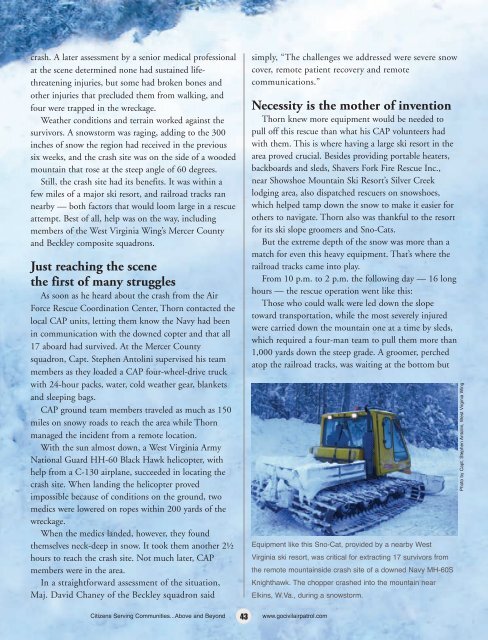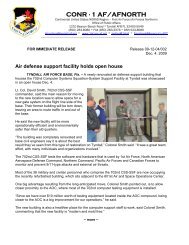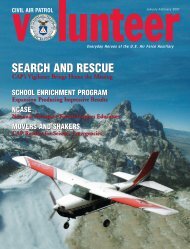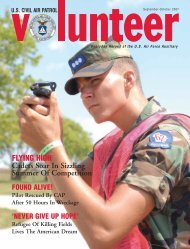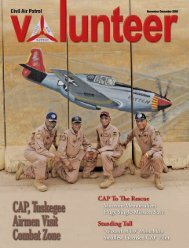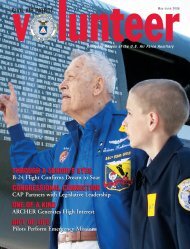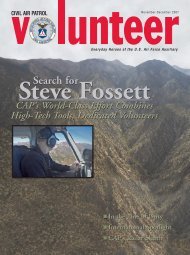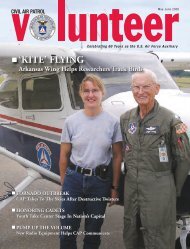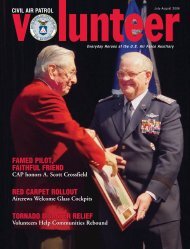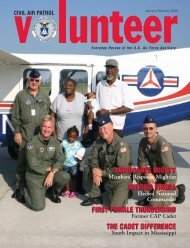You also want an ePaper? Increase the reach of your titles
YUMPU automatically turns print PDFs into web optimized ePapers that Google loves.
crash. A later assessment by a senior medical professional<br />
at the scene determined none had sustained lifethreatening<br />
injuries, but some had broken bones and<br />
other injuries that precluded them from walking, and<br />
four were trapped in the wreckage.<br />
Weather conditions and terrain worked against the<br />
survivors. A snowstorm was raging, adding to the 300<br />
inches of snow the region had received in the previous<br />
six weeks, and the crash site was on the side of a wooded<br />
mountain that rose at the steep angle of 60 degrees.<br />
Still, the crash site had its benefits. It was within a<br />
few miles of a major ski resort, and railroad tracks ran<br />
nearby — both factors that would loom large in a rescue<br />
attempt. Best of all, help was on the way, including<br />
members of the West Virginia Wing’s Mercer County<br />
and Beckley composite squadrons.<br />
Just reaching the scene<br />
the first of many struggles<br />
As soon as he heard about the crash from the Air<br />
Force Rescue Coordination Center, Thorn contacted the<br />
local CAP units, letting them know the Navy had been<br />
in communication with the downed copter and that all<br />
17 aboard had survived. At the Mercer County<br />
squadron, Capt. Stephen Antolini supervised his team<br />
members as they loaded a CAP four-wheel-drive truck<br />
with 24-hour packs, water, cold weather gear, blankets<br />
and sleeping bags.<br />
CAP ground team members traveled as much as 150<br />
miles on snowy roads to reach the area while Thorn<br />
managed the incident from a remote location.<br />
With the sun almost down, a West Virginia Army<br />
National Guard HH-60 Black Hawk helicopter, with<br />
help from a C-130 airplane, succeeded in locating the<br />
crash site. When landing the helicopter proved<br />
impossible because of conditions on the ground, two<br />
medics were lowered on ropes within 200 yards of the<br />
wreckage.<br />
When the medics landed, however, they found<br />
themselves neck-deep in snow. It took them another 2½<br />
hours to reach the crash site. Not much later, CAP<br />
members were in the area.<br />
In a straightforward assessment of the situation,<br />
Maj. David Chaney of the Beckley squadron said<br />
Citizens Serving Communities...Above and Beyond<br />
43<br />
simply, “The challenges we addressed were severe snow<br />
cover, remote patient recovery and remote<br />
communications.”<br />
Necessity is the mother of invention<br />
Thorn knew more equipment would be needed to<br />
pull off this rescue than what his CAP volunteers had<br />
with them. This is where having a large ski resort in the<br />
area proved crucial. Besides providing portable heaters,<br />
backboards and sleds, Shavers Fork Fire Rescue Inc.,<br />
near Showshoe Mountain Ski Resort’s Silver Creek<br />
lodging area, also dispatched rescuers on snowshoes,<br />
which helped tamp down the snow to make it easier for<br />
others to navigate. Thorn also was thankful to the resort<br />
for its ski slope groomers and Sno-Cats.<br />
But the extreme depth of the snow was more than a<br />
match for even this heavy equipment. That’s where the<br />
railroad tracks came into play.<br />
From 10 p.m. to 2 p.m. the following day — 16 long<br />
hours — the rescue operation went like this:<br />
Those who could walk were led down the slope<br />
toward transportation, while the most severely injured<br />
were carried down the mountain one at a time by sleds,<br />
which required a four-man team to pull them more than<br />
1,000 yards down the steep grade. A groomer, perched<br />
atop the railroad tracks, was waiting at the bottom but<br />
Equipment like this Sno-Cat, provided by a nearby West<br />
Virginia ski resort, was critical for extracting 17 survivors from<br />
the remote mountainside crash site of a downed Navy MH-60S<br />
Knighthawk. The chopper crashed into the mountain near<br />
Elkins, W.Va., during a snowstorm.<br />
www.gocivilairpatrol.com<br />
Photo by Capt. Stephen Antolini, West Virginia Wing


